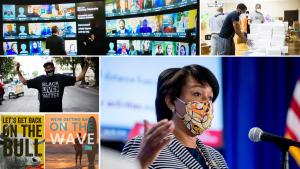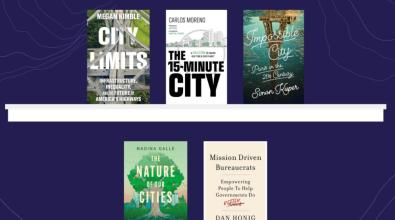2020 Year in review: 5 bright spots in a difficult year

For local government leaders, 2020 has been the leadership challenge of a lifetime — a powerful and sobering journey through a global pandemic, economic collapse, and a nearly constant churn of crisis.
While most are happy to see this difficult year come to a close, it wasn’t all bad. In fact, for city leaders looking to boost innovation, collaboration, and racial equity, there were positive developments that they can look forward to building on in 2021. As Michael R. Bloomberg, founder of Bloomberg Philanthropies and three-term Mayor of New York City told city leaders in September, “You’re doing a great job. Mayors are the ones that are really providing common sense and leadership.”
Here are five bright spots that emerged in city halls in a trying year.
1. Innovation becomes everyone’s job
The pandemic’s head-spinning early days were a traumatic time of loss, disruption, and despair. They also were an inspiring moment when countless city leaders stepped up to the moment and responded quickly to problems they’d never imagined.
Practically overnight, they were out rounding up donations of masks, gloves, and other protective equipment; launching COVID testing centers and turning convention centers into field hospitals; firing up relief funds for small businesses and residents at risk of eviction; standing up food delivery networks for seniors and children; opening streets for safe social distancing; and so much more.
It was the quintessential all-hands-on-deck moment. With some city services temporarily shut down, librarians pitched in at homeless shelters, parks and recreation departments stood up food delivery services, and school nurses redeployed as contact tracers. The silos that so often stand in the way of collaboration evaporated. In many city halls, managers and frontline staff said they were excited to find themselves working side-by-side with people from other departments they’d never even met before.
This period of collaboration, creativity, and can-do spirit may be looked back on some day as a moment when public-sector innovation became everyone’s job. To boost these efforts, Mike Bloomberg launched the COVID-19 Local Response Initiative to support mayors and key staff members with access to world-class leadership training and public-health insights.
Read more:
Crises demand innovation; here’s how to do it best
Cities redeploy non-essential staff to provide critical services
It’s time for civic innovators to document their COVID work
Cities double down on innovation, even as they tighten their belts
2. Racial equity moves to the top of the agenda
In late May, city streets across the U.S. filled with protests against racial injustice when George Floyd, a Black resident of Minneapolis, died after a White police officer kneeled on his neck during an arrest. In many city halls, the demonstrations sparked long overdue conversations about how to address police brutality and other dimensions of systemic racism, such as the pandemic’s disproportionate toll on people of color.
Those conversations aren’t easy, and the outcome remains far from clear. But a growing number of cities are experimenting with shifting funds from policing to crime prevention, using data tools to advance equity in local government, and putting equity at the center of their plans for rebuilding local economies. Keeping that momentum going through a challenging budget environment is a goal of the expert coaching and technical assistance mayors and their top budget and finance leaders are getting through the Bloomberg Philanthropies City Budgeting for Equity & Recovery Program.
Read more:
4 ways data can help cities become more equitable
The road to recovery and equity in an already-challenged economy
Why cities should put equity at the center of their COVID-19 response
Lessons from Chicago’s COVID-19 Racial Equity Rapid Response Team
3. Telework and virtual meetings make big strides
Before the pandemic, most local governments generally did not allow employees to telework, which sometimes hurt in recruiting and retaining talent. But when stay-at-home orders and social distancing flipped office culture upside down, cities adapted fast to enable staff who could work from home to do so. The shift went better than skeptics expected. Many city halls are now working through policy, technical, and managerial changes needed to make some amount of work-from-home flexibility a permanent feature.
A similar shift happened with city council meetings and other public hearings. With great speed, cities worked through the technical and parliamentary logistics of meeting online or in hybrid virtual and in-person formats. These changes didn’t always go off without a hitch, but with many cities reporting big surges in public participation at online meetings and telephone town halls, there’s reason to hope leaders can use this moment as a catalyst for finding ways to engage more residents and more diverse voices than they have in the past.
Bloomberg Philanthropies’ programming for city leaders made the switch to virtual this year, as well. Leadership training classes for mayors and their senior staff through the Bloomberg Harvard City Leadership Initiative moved online, as did innovation training programs in which teams of city leaders are learning how to use human-centered design to solve critical local problems.
Read more:
Teleworking, and what one city is learning about working from home
7 tips for achieving real city innovation in today’s virtual world
How virtual financial counseling is boosting people’s bottom line
4. Cities share and learn together to achieve greater impact
In a year of constant crisis and change, city leaders never stopped sharing ideas and learning from one another’s experiences. Via organized Zoom sessions and informal group texts, mayors across the country stayed connected to bounce ideas off each other, strategize, and commiserate.
Those connections paid dividends as cities built COVID testing, contact-tracing, rent relief, and dozens of other programs and services at a scale they’d never imagined. Cities were able to innovate faster by borrowing ideas, lessons learned, and even entire websites from each other.
Durham, N.C., for example, took substantial portions of a program to boost local facemask manufacturers from Seattle and Los Angeles and lent portions of another program aimed at small businesses to Honolulu. This, and countless more adaptations like it, are examples of what British author Charles Leadbeater recently called “the most effective innovation in a crisis … using existing knowledge and skills to repurpose existing technologies.”
In 2020, Bloomberg Philanthropies helped keep city leaders connected and learning from each other in various ways, including the learning-and-coaching sessions of the COVID-19 Local Response Initiative, the launch of a COVID-19 Local Action Tracker, biweekly online convenings of city chief innovation officers, and the recent launch of the new Bloomberg Cities Network website.
Read more:
How networks between cities can foster faster and better innovation
Helping cities solutions spread: How we think about 'replication' at Bloomberg Philanthropies
5. Data becomes top news
The pandemic may be a watershed moment for how city leaders use data to communicate with the public. In their press briefings and Q&As with residents, mayors have grown comfortable citing and explaining datapoints like the local test positivity rate. Meanwhile, local COVID-19 data dashboards have become popular features on many cities’ websites.
Behind the scenes, mayors are becoming deft at using the data from these dashboards and other sources to drive decisions about everything from when to open or close certain businesses to whether to step up enforcement of facemask mandates. And city staff are working hard at setting up the systems that enable it all to happen, from forging data-sharing agreements with counties and states, to breaking down data by race or ZIP code, to using visualizations to show trends and tell stories with the numbers. The lessons learned can accelerate how cities use data in other ways after the pandemic.
Read more:
COVID-19 Management Metrics for Cities
How cities can flatten the curve again
How data-driven innovation is fueling cities’ COVID response
How Philadelphia is cracking the code for measuring mask compliance


